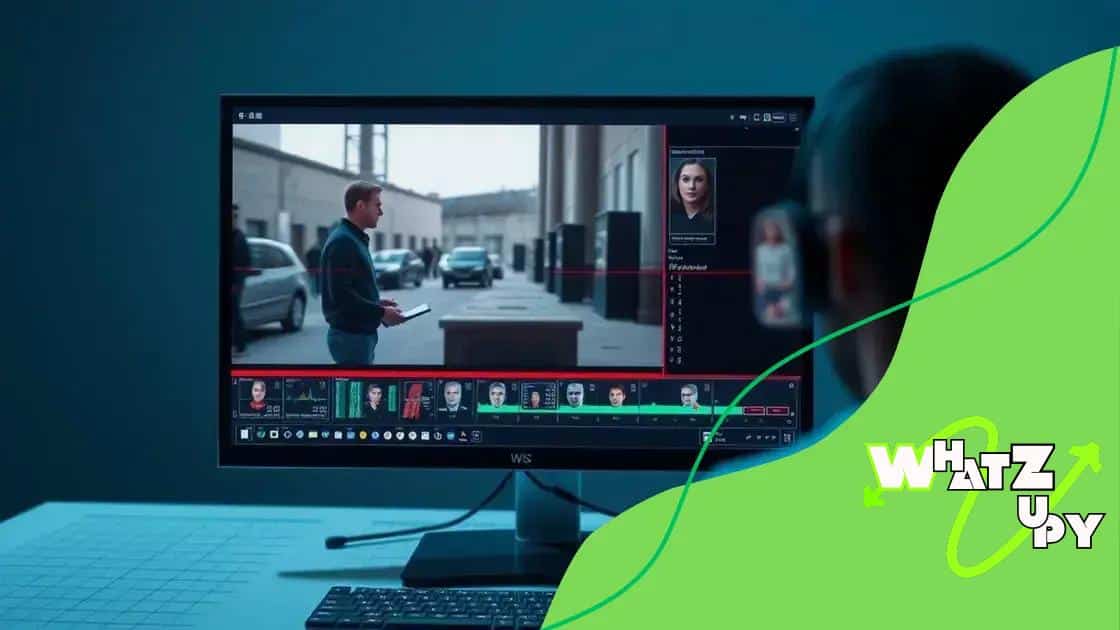Leveraging AI to detect deepfake content is crucial

Leveraging AI to detect deepfake content involves using advanced algorithms and machine learning techniques to identify manipulated media, protecting against misinformation and enhancing digital trust.
Leveraging AI to detect deepfake content is becoming increasingly important in our digital age. With misinformation spreading like wildfire, how can we trust what we see online anymore?
Understanding deepfake technology
Understanding deepfake technology is essential as it becomes more prevalent in our daily lives. Deepfakes use artificial intelligence to create hyper-realistic fake videos or audios. They can be used for fun, but they also pose risks of misinformation and fraud.
At its core, deepfake technology leverages machine learning techniques. This involves training AI models on vast amounts of data to replicate voices and images convincingly. Let’s explore how this technology works and its implications.
How Does Deepfake Technology Work?
Deepfake technology primarily relies on a type of AI called deep learning. This method includes using neural networks to unravel complex patterns in data. Here’s how it basically operates:
- The AI collects large datasets of images or videos of a person.
- It learns to mimic the facial expressions and movements of that individual.
- The model generates new videos, making it appear as if the person is saying or doing something they never actually did.
Due to its capability to manipulate reality, it becomes crucial to recognize and understand deepfakes. By doing so, we can contribute to the fight against misinformation.
Potential Risks of Deepfake Technology
While deepfakes can serve fun purposes, they also carry significant risks. Misinformation can spread quickly, influencing public opinion and causing harm. In political contexts, they can be used to create fake speeches from leaders. In personal scenarios, deepfakes can lead to harassment or defamation.
Moreover, as the technology evolves, detecting deepfakes has become increasingly challenging. Here are some potential risks:
- Manipulation of public figures’ statements.
- Creation of fake news intended to mislead.
- Undermining trust in legitimate media.
By understanding the intricacies of deepfake technology and its potential dangers, we equip ourselves with the knowledge to navigate its implications in our lives.
How AI detects deepfakes
How AI detects deepfakes is a critical topic in today’s world. With the rise of fake videos and audios, understanding the technology that makes detection possible is essential. AI uses various algorithms and techniques to identify signs of manipulation.
One of the primary ways AI detects deepfakes is through analyzing inconsistencies in images and audio. This can include facial movements, voice inflections, and even background artifacts that do not match the genuine elements.
Techniques Used in Deepfake Detection
AI employs several techniques to spot deepfakes. These methods often involve both image processing and audio analysis. Here are some key techniques:
- Facial recognition algorithms that evaluate the alignment of facial features.
- Temporal inconsistencies that track movements over time.
- Pixel-level analysis to check for unnatural alterations in the image.
These innovative detection techniques are evolving quickly, making it crucial to stay updated with the latest developments in AI.
The Role of Machine Learning
Machine learning plays a vital role in the detection process. By training models on vast datasets, AI can learn to recognize patterns of both genuine and fake media. This training allows the technology to become more effective over time as it encounters new deepfake examples.
Moreover, the feedback loop created by user interactions helps improve detection accuracy. As users report deepfakes, the AI system learns from these inputs, refining its ability to identify future instances.
In summary, understanding how AI detects deepfakes reveals an intricate dance of technology and analysis. By leveraging advanced algorithms and large datasets, AI remains a powerful tool in the fight against misinformation.
Real-world applications of AI in deepfake detection

Real-world applications of AI in deepfake detection are crucial as they address the growing concern of misinformation. Various industries are stepping up to incorporate AI tools to combat the threat posed by fake media.
One of the most significant areas is the entertainment industry, where filmmakers use AI to ensure that the materials they release are genuine. This practice helps them maintain their reputation and protects audiences from misleading content.
AI in News Organizations
News organizations have recognized the importance of deepfake detection as part of their editorial processes. They employ AI tools to analyze videos and identify any signs of manipulation. This not only ensures the credibility of their reporting but also makes consumers more confident in the news they consume.
- Fact-checking articles with AI tools to verify video authenticity.
- Utilizing software to monitor and flag potential deepfakes.
- Training journalists on how to discern authentic content from fake.
The effectiveness of these efforts is significant as it helps combat the spread of false information, especially in fast-paced news cycles.
Government and Law Enforcement
Another critical application of AI in deepfake detection is seen in government and law enforcement agencies. These organizations utilize AI to identify and investigate instances of deepfake usage in various contexts, such as fraud or cybercrime. By doing this, they enhance their ability to maintain order and protect citizens.
For example, they can track deepfake videos that may harm political figures or incite violence. The swift action taken using AI tools allows for timely responses to potential threats.
As AI technology continues to develop, its real-world applications in deepfake detection will become even more pervasive, fostering a safer digital environment.
Challenges in deepfake detection
Challenges in deepfake detection are significant as the technology continues to evolve. While AI plays a crucial role in identifying deepfakes, there are still many hurdles to overcome. Understanding these challenges helps in developing more effective detection methods.
One major issue is the rapid advancement of deepfake technology itself. With each new method to create fake content, existing detection tools must adapt quickly. This race between creation and detection often leads to a gap in effective control.
Quality and Realism
The best deepfakes can be incredibly realistic. They often use high-resolution images and advanced techniques that make it difficult for humans and machines to tell what is real. This high quality means that detection algorithms must be extremely sophisticated to identify even the slightest discrepancies.
- Realistic facial expressions that closely mimic genuine emotions.
- High-quality audio that matches the video perfectly.
- Seamless integration with backgrounds and environments.
These factors make it essential for AI models to continuously improve as the bar for deepfake quality rises.
Data Limitations
Another challenge arises from the availability and quality of training data. Training AI models to detect deepfakes requires large datasets of both genuine and fake content. However, obtaining a sufficiently diverse dataset can be difficult. If the model is trained on limited samples, it might perform poorly in real-world scenarios, making it ineffective in identifying deepfakes.
Additionally, malicious actors may create deepfakes specifically designed to evade detection tools. This adversarial approach forces developers to constantly update their models and strategies.
Overall, the challenges in deepfake detection highlight the need for ongoing research and development, emphasizing the importance of staying ahead of trends to effectively combat misleading content.
Future trends in AI and deepfake technology
Future trends in AI and deepfake technology will significantly shape how we interact with digital content. As both technologies evolve, their implications on society, media, and personal security will grow. Understanding these trends is essential for staying informed.
One primary trend is the increasing sophistication of deepfake creation tools. These tools will likely become more accessible to the general public, resulting in a rise in deepfake content. As a result, the need for robust detection systems will become even more critical to combat misinformation.
Advancements in Detection Techniques
As deepfake technology advances, AI-based detection techniques will also improve. Researchers are developing new algorithms that can identify deepfakes with greater accuracy. Here are some of the expected advancements:
- Machine learning models that adapt to new deepfake styles.
- Real-time detection methods that can be integrated into social media platforms.
- Improved analysis of audio-visual synchronization to spot inconsistencies.
These advancements will help create a safer digital environment, allowing people to trust the authenticity of their content.
Regulatory and Ethical Considerations
As deepfake technology continues to evolve, regulatory and ethical considerations will also gain importance. Governments and organizations will likely implement guidelines to manage the use of deepfakes. These regulations may include:
- Legal frameworks defining the acceptable use of deepfake technology.
- Mandatory disclosures for content creators regarding AI-generated media.
- Consequences for those who misuse deepfake technology for malicious purposes.
Raising awareness and fostering responsible use of these technologies will be crucial in the coming years.
The future of AI and deepfake technology holds both promise and challenges. As we navigate these changes, staying informed about new developments will empower individuals, businesses, and society to respond effectively.
AI and deepfake technology is essential as it continues to impact our world. We’ve explored its applications, challenges, and future trends, revealing how both technology and detection methods are evolving. As deepfakes become more prevalent, so does the need for effective detection systems and ethical guidelines. By staying aware of these developments, we can better navigate the digital landscape and protect ourselves from misinformation.
FAQ – Frequently Asked Questions about AI and Deepfake Technology
What are deepfakes?
Deepfakes are realistic media, including videos and audio, that use AI to manipulate or fabricate content, often making it appear as if someone is saying or doing something they didn’t.
How can AI help in detecting deepfakes?
AI can analyze videos and audio for inconsistencies, such as mismatched facial movements or unnatural voice patterns, to identify potential deepfakes.
What are the challenges in deepfake detection?
The challenges include the high quality of deepfakes that make detection difficult, and the need for up-to-date training data for detection algorithms.
What future trends should we expect in deepfake technology?
Future trends include advancements in detection tools, increased accessibility of deepfake creation technology, and the establishment of ethical guidelines and regulations.





